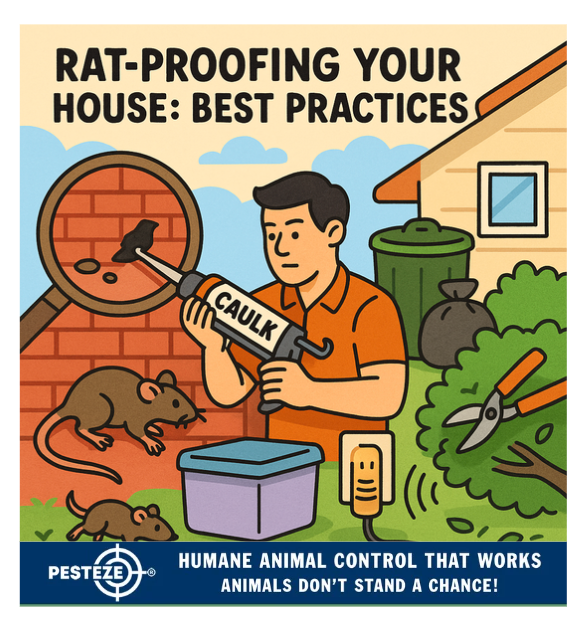RAT-PROOFING YOUR HOUSE: BEST PRACTICES

RAT-PROOFING YOUR HOUSE: BEST PRACTICES
SUMMARY
This guide outlines the most effective strategies to prevent rats from entering and nesting in your home. Learn how to identify vulnerabilities, seal entry points, eliminate food sources, and maintain a clean environment to keep your property permanently rat-free.
FEATURES
-
Inspect Regularly: Check walls, attics, and basements for gnaw marks and droppings.
-
Seal Entry Points: Close holes with steel wool, caulk, or hardware cloth.
-
Eliminate Food Sources: Store food in airtight containers.
-
Maintain Cleanliness: Keep kitchens, pantries, and outdoor areas tidy.
-
Trim Vegetation: Cut back tree branches and shrubs near your home.
-
Use Deterrents: Consider ultrasonic repellents or natural deterrents like peppermint oil.
GUIDE DESCRIPTION
Rats are intelligent and resourceful creatures capable of squeezing through openings as small as half an inch. Once inside, they can cause costly damage to wiring, insulation, and stored goods, as well as spread disease through their droppings and urine. The best defense against a rat infestation is a proactive one: rat-proofing your home before they can move in.
Begin by inspecting your home’s exterior and interior for signs of rat activity. Look for gnaw marks, oily rub marks, droppings, and small holes along walls or near utility lines. Pay close attention to areas where pipes and cables enter the house, as these are common access points. Use a flashlight to check dark corners, attics, and crawl spaces. Once identified, seal these openings using durable, rodent-proof materials such as steel wool, caulk, or hardware mesh. Avoid using soft sealants like foam, as rats can easily chew through them.
Maintaining cleanliness is another crucial step. Rats are drawn to easily accessible food sources, so always store dry goods in sealed containers and clean up crumbs or spills promptly. Garbage should be kept in tightly closed bins, both indoors and outdoors. Compost piles and pet food should also be monitored closely, as they can attract rodents quickly. Regularly vacuuming and decluttering spaces reduces hiding spots and nesting materials.
Outdoors, make your property less inviting to rats by trimming overgrown vegetation, shrubs, and tree branches that touch or overhang the roof. Remove piles of debris, wood, and leaves near your home, as these provide ideal nesting areas. If you have a garden, harvest ripe produce promptly and use mesh or fencing to protect it.
In addition to physical prevention, consider using deterrents to make your home even less appealing. Ultrasonic repellents, for example, emit high-frequency sounds that are unpleasant to rodents but safe for humans and pets. Natural deterrents, like peppermint or eucalyptus oil, can also be effective when placed near entry points and baseboards.
Lastly, schedule regular inspections even after implementing these preventive measures. Rats are persistent, so vigilance is key to keeping them out for good. By combining sealing, cleaning, and deterrent strategies, you can create an environment that’s unwelcoming to rodents — ensuring your home remains safe, clean, and pest-free.
- Saneeth Thota


Comments 0